m (1.7 Removing duplicate link(s), fixed redirects) |
|||
| Line 26: | Line 26: | ||
*The [[Sentience|semi-sentient]] [[sarlacc]] reproduced via plantlike spores, although very few took root.<ref name="NEGAS">''[[The New Essential Guide to Alien Species]]''</ref> |
*The [[Sentience|semi-sentient]] [[sarlacc]] reproduced via plantlike spores, although very few took root.<ref name="NEGAS">''[[The New Essential Guide to Alien Species]]''</ref> |
||
| − | Some species were fully '''parthenogenetic'''-that is, every member of the species |
+ | Some species were fully '''parthenogenetic'''-that is, every member of the species was female and reproduced without fertilization. Theoretically, the offspring should therefore be genetically identical to its mother, which was the nature of '''parthenogenesis'''.<ref>''[[Alien Encounters]]'', p. 132</ref> [[M'shinn]] were a [[humanoid]] species in which every individual was female, who reproduced through a form of parthenogenesis. In areas where their food was plentiful, a M'shinn would give birth to a single infant once every standard three [[year]]s. All M'shinni looked almost identical, although each generation's genetic code was subtly altered.<ref name="GG12">''[[Galaxy Guide 12: Aliens — Enemies and Allies]]''</ref> The [[Reptile|reptilian]] [[Sekct]] were fully parthenogenetic. Every individual would lay a single egg every two years, from which a single infant hatched. The genetic code of the Sekct were very susceptible to change, and random mutations ensured that each offspring was different from its parent.<ref name="Alien Encounters">''[[Alien Encounters]]''</ref> |
[[File:BobaJango CVD.jpg|thumb|right|180px|Jango Fett with his clone son, Boba.]] |
[[File:BobaJango CVD.jpg|thumb|right|180px|Jango Fett with his clone son, Boba.]] |
||
[[Cloning]] referred to the process of reproducing a near symmetrical duplicate of a being through artificial means. [[Boba Fett|Boba]] was created by [[Kaminoan]]s as an unaltered clone, at the request of his "father", the [[Mandalorian]] [[bounty hunter]] [[Jango Fett]].<ref>[[Star Wars: Episode II Attack of the Clones|''Star Wars'': Episode II ''Attack of the Clones'']]</ref> Boba was raised as Jango's offspring, and his father always put his son first-like any father should, according to Boba.<ref>''[[Legacy of the Force: Bloodlines]], p. 2</ref> During the [[Clone Wars]], [[Vianna D'Pow]], a [[Zeltron]] [[albino]] bounty hunter, placed an order for a solitary clone of herself from Kaminoan cloners.<ref>{{CWACite|8|One of a Kind (comic)|One of a Kind}}</ref> |
[[Cloning]] referred to the process of reproducing a near symmetrical duplicate of a being through artificial means. [[Boba Fett|Boba]] was created by [[Kaminoan]]s as an unaltered clone, at the request of his "father", the [[Mandalorian]] [[bounty hunter]] [[Jango Fett]].<ref>[[Star Wars: Episode II Attack of the Clones|''Star Wars'': Episode II ''Attack of the Clones'']]</ref> Boba was raised as Jango's offspring, and his father always put his son first-like any father should, according to Boba.<ref>''[[Legacy of the Force: Bloodlines]], p. 2</ref> During the [[Clone Wars]], [[Vianna D'Pow]], a [[Zeltron]] [[albino]] bounty hunter, placed an order for a solitary clone of herself from Kaminoan cloners.<ref>{{CWACite|8|One of a Kind (comic)|One of a Kind}}</ref> |
||
Revision as of 00:49, 16 November 2014
| | |
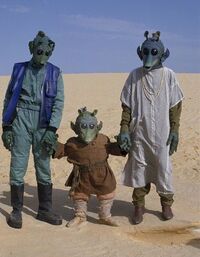
Rodian parents with their offspring.
- Ben: "My dad loves me very much."
- Luke: "True, and when you become a father, you'll discover how true that is."
- ―Luke and Ben Skywalker on Nam Chorios[src]
A parent was the progenitor of biological offspring. Some species, such as exogorths, had only one, asexually reproducing parent. Most species, however, reproduced sexually: a male or female parent was called a father or a mother, respectively. Parent also referred to a caretaker of the offspring. In many societies across the galaxy, the biological parents were responsible for raising their young; however, this varied from species to species, and between different cultures. Sometimes, a child, or youngling, would be raised by their grandparents or other family members. Some parents, such as adoptive parents, were not biologically related to their children at all.
Biological parent
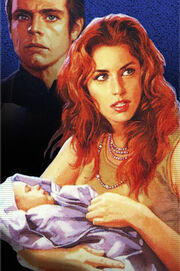
Human parents Luke and Mara Jade Skywalker with their newborn son, Ben.
- "Now I have something wonderful, something I have chosen. And I will never let anyone take the child I' m carrying."
- ―From the private journal of Etain Tur-Mukan
One of the important criteria that formed a universal definition of "life", was reproduction: living organisms create more living organisms.[1] Some people believed that the very purpose of life was to create new life, and that creating life was the greatest act a living creature could commit.[2]
One progenitor
- "You are a clone. That means you are my son. Period. No one else, no woman was involved."
- ―Jango Fett, to his son, Boba
Some species had only one progenitor. Most gastropods, for example, reproduced asexually,[3] and plant-based species reproduced themselves[4].
Notable examples were:
- Assemblers, an arachnids species which created drones to carry out day-to-day affairs. These drones, called nodes, were created from the essence of the Assembler's web, and were both part of the Assembler and separate from them. New Assemblers evolved from these nodes.[5]
- The exogorth, or space slug, reproduced through fission, in which the slug split in two smaller slugs.[6]
- Filordi were asexual and reproduced while dying. A week after its "parent" has died, an infant Filordus crawls from the corps of its predecessor.[7][8]
- Hutts were hermaphrodites who contained both male and female reproductive organs.[9] They needed no partner to produce a child.[10] However, some Hutts did actually have both a mother and a father; one example was Ziro the Hutt[11] and the son of Anachro and Gorga the Hutt.[12].
- The Neti were a plant-based species who, like most plants, procreated by producing a few seeds.[5]
- The semi-sentient sarlacc reproduced via plantlike spores, although very few took root.[9]
Some species were fully parthenogenetic-that is, every member of the species was female and reproduced without fertilization. Theoretically, the offspring should therefore be genetically identical to its mother, which was the nature of parthenogenesis.[13] M'shinn were a humanoid species in which every individual was female, who reproduced through a form of parthenogenesis. In areas where their food was plentiful, a M'shinn would give birth to a single infant once every standard three years. All M'shinni looked almost identical, although each generation's genetic code was subtly altered.[14] The reptilian Sekct were fully parthenogenetic. Every individual would lay a single egg every two years, from which a single infant hatched. The genetic code of the Sekct were very susceptible to change, and random mutations ensured that each offspring was different from its parent.[15]
Jango Fett with his clone son, Boba.
Cloning referred to the process of reproducing a near symmetrical duplicate of a being through artificial means. Boba was created by Kaminoans as an unaltered clone, at the request of his "father", the Mandalorian bounty hunter Jango Fett.[16] Boba was raised as Jango's offspring, and his father always put his son first-like any father should, according to Boba.[17] During the Clone Wars, Vianna D'Pow, a Zeltron albino bounty hunter, placed an order for a solitary clone of herself from Kaminoan cloners.[18]
Two progenitors
- "Something wonderful has happened."
- ―Padmé Amidala tells her husband that she's pregnant
Many species had two progenitors. Most of these species reproduced sexually, with one female progenitor and one male.
For some, the process of creating a new organism involved the fusion of cells from each parent;[19] examples were Bith,[9] Bothans[19] and Humans[19]. Many species who reproduced by laying eggs. For some of them, sera from one parent fertilized the egg created by another parent. Reptilians, for example, reproduced by laying fertilized eggs[4] (although the Sekct of the planet Marca actually reproduced without fertilization[15]). Other notable examples were the amphibious Ishi Tib[9] and Issori[20], and the insectoid Verpine[21].
Some species were actually genderless, but two individuals were still required in order to create offspring. Notable examples included:
- Aganof, who were androgynous. They had both male and female characteristics and laid fertilized eggs after mating.[15]
- The plant-like Ergesh were asexual beings and had no concept of gender. They reproduced by a species ritual in which two Ergesh each produced a seed that was then planted together in a swamp.[15]
- Proteans were silicon-based life forms. Even though they were genderless, they still paired off to reproduce. Two Proteans would merge into a single entity, which would eventually crack open and revealing the original Protean pair and a newborn.[15]
- Verpine were insectoid hermaphroditics. When an increase in population was needed, some individuals produced the eggs, while others provided the necessary sera.[21]
Members of different species were usually incapable of producing viable offspring;[1] although exceptions to the rule did exist. An individual with parentage from more than one sentient species was known as a hybrid. Humans, for example, were able to inter-breed with Near-Humans with few exceptions[9] and could also interbreed with the Coynite,[22] Twi'lek[23] Kalai[24] and Sith[25]. Other compatible hybrid combinations included Borneck with Etti,[26] and Arkanian with Sephi[27]. Bothans were able to interbreed with at least one species, resulting in the so-called half-Bothans.[28] Some species could interbreed only with the help of genetic manipulation; Humans could interbreed with Anzati, Qiraash, Rattataki and Umbarans this way.[29] Many species ostracized members who bore hybrid children.[30]
Others
The Shards of Orax were a unique life form. These silicone-based sentient crystals did not reproduce and had no progenitors in the common sense of the word. They formed from an interaction between the ion-charged atmosphere of their homeworld and the natural crystals and mineral-rich water, "growing" Shards in clusters. When a Shard had reach full size and “adulthood”, the accretion of crystal would begin to produce a new Shard.[31][15]
The Bartokk were a mysterious insectoid species with exceptional regenerative abilities. If their brain was cut in half, each half would regenerate into a separate twin, creating an entirely new individual.[8]
Adoption
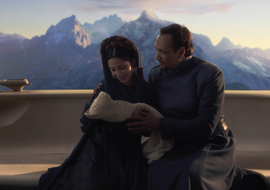
Bail and Breha Organa with their newly adopted daughter.
- "I was accepted as their child everywhere we went. I almost forgot where I was from, until I looked in the mirror."
- ―Rush Clovis, a Human who was adopted by a Muun when he was twelve
Adoption was a process where a person assumed the parenting for another. An adoptive parent is one who nurtures and raises the offspring of the biological parents but may not be related to the youngling.
The actual process varied from planet to planet, and between different cultures. On the planet Coruscant, people who wanted to adopt had to fill in an application and several datafiles, and gather "all the other stuff" that the official would want before the actual adoption took place.[32] Among the Mandalorians, on the other hand, the process was rather simple. In a ritual known as the gai bal manda — "name and soul", a prospective Mandalorian parent needed only to recite the phrase ni kyr'tayl gai sa'ad — "I know your name as my child" — followed by the name of the individual to be adopted.[33]
Humans (and presumably many other species) viewed adoption as charitable.[34] Some people chose to become adoptive parents because they could not have any children of their own; for example, Bail and Breha Organa had many difficulties in producing an heir, and doctors had informed them that another attempt to conceive a child would probably kill Breha.[35] This led to discussions about adopting a baby girl, and the adoption of their daughter Leia.[36] Sometimes, a stepparent would adopt a stepchild.[37]
On the planet Gand, the so-called Findsmen of the species would sometimes find a child for couples who could not conceive. The Findsmen would wander into the enshrouding mists of the planet and find the child they desired. These "mistborn" children were a gift and raised by the people as their own.[2]
Adoption was extremely common in Mandalorian culture, even adoption of adults. [38] As a warrior-people, Mandalorians had a savage reputation, but they cherished family life. Adoption of war orphans was quite common, even children of a defeated enemy, whereas other species might kill them. The Mandalorian way of life was a dangerous one, and Mandalorian families never hesitated to adopt orphans.[33] Despite the importance placed on fidelity and chastity prior to marriage,[33] a partner who acted unfaithfully during a long separation would be forgiven so long as any child that resulted from the indiscretion was raised together by the couple.[39] Adoption could even be done posthumously.[40]
Some species had no need for adoption. A notable example was the Issori species. On their homeworld Issor, the conception of a new child was something that was negotiated between families, and not connected to romantic love at all. Families would agree on breedings (a process in which eggs which were fertilized by an agent packet), and the families would raise the children. Therefore, they had no unwanted children, and even those who were orphaned were the responsibility of the families of those who were bred to create them.[41]
Step-parent
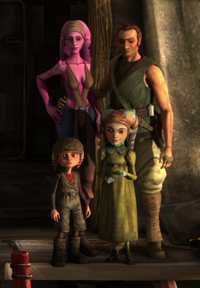
Cut Lawquane with his wife and step-children, Jek and Shaeeah.
- "She took you and your sister as her own, straight away. She cared for you both so much, Finn, and you instantly bonded with her. She'd lost so much as a slave. She hadn't thought she'd ever have her own life, let alone a life that included something as special as you two. You were everything."
- ―Caled Galfridian tells the story about his wife to his son, Finn
A stepmother or stepfather was the spouse of one's biological parent and not one's natural mother of father. If the other biological parent was deceased or had moved out of their children's life, the stepparent would often take their place as the second parent to the children; examples of this includes Shmi Skywalker Lars and her new family after she married Cliegg Lars,[42] clone trooper deserter Cut Lawquane, who married Suu Lawquane and adopted her two children, Jek Lawquane and Shaeeah Lawquane;[37] and Nina Galfridian and her family[43].
Hold-parent
A hold-parent was a close friend of a youngling's parents and an honorary title. Hold-parents would often bring gifts and toys to the child. In extreme circumstances, a hold-parent might assume the parenting of the youngling if something happened to the parents.[44]
Grandparent
- Leia: "Not ready to become a grandmother yet?"
- Mara: "I think I'd throw myself on my lightsaber first."
- Leia: "I think I'm ready. I plan to be the sort of feisty, bad-example grandmother who teaches her grandchildren deplorable habits. [To Jacen] How long should I expect to wait?"
- Jacen: "If you're trying to embarrass me, you're talking into a dead comlink."
- Leia: "Not embarrass. I'm just trying to get a timetable."
- Jacen: "Ask Jaina."
- Leia: "She said to ask you."
- ―Leia Organa Solo having a relaxed conversation with her son and her sister-in-law[src]
Grandparents were the parents of a person's own parent, whether that be a father or a mother. One could also be a step-grandparent.[45] A female grandparent was called a grandmother and a male grandparent a grandfather. "Grandmother" and "grandfather" were the same word in Mando'a, the Mandalorian language (which was gender-neutral).[46]
Norms and customs
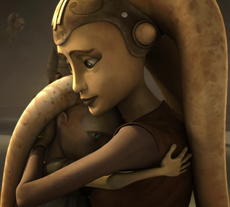
A Twi'lek mother with her her child.
- "This is a happy moment. The happiest moment of my life."
- ―Anakin Skywalker is delighted to hear about his wife's pregnancy
The norms and customs concerning reproduction and parenting varied greatly between species, and sometimes within different cultures of a species. The Horansi, for example, were comprised of several sup-species. Though they could cross breed, these occurrences were rare, primarily due to cultural differences.[15]
Valuing children
- "There are two truths... in my life. I loved your father and... whatever you may think... however it seems... I love you."
- ―Morrigan Corde to her son
The way parents valued their offspring varied between species as well. Among the Ebranite, for instance, children were seen as little more than slaves, and had very little freedom.[14] Neimoidian young were raised in communal hives from berth, where they had only limited amounts of food. Many died as a result.[9] The Ortolans had few children. Education of the offspring was the responsibility of the parents, who pass their knowledge and skills they learned from their parents on to their children. When a child shows extraordinary aptitude in skills that are beyond the parents' expertise, they ask another Ortolan family to teach the child in return for some other service. However, parental obligations end when the child reaches an age equivalent to seven years old, at which time they are simply thrown out of the house to forage on their own[21] and fend for themselves[9] This is done in order to conserve the family's supplies, although exceptions are sometimes granted for children with a talent particularly valuable to the family's well-being.[9] Tusken Raiders cared for their children, but they were not considered people until they had endured a ceremony that declared their adulthood. Babies often perished because of the harsh desert life, and Tusken Raiders took great pride knowing that only the strongest survived.[9]
The Tyerell family. Aleena were fiercely devoted to their families, and would often travel as a unit when they left their homeworld.[9]
However, there were many species where parents were expected to love their children and be their teachers and protectors. The planet Cona, for instance, was a dangerous place for the immature and uninitiated, and the Arcona society arose from the need to ensure the safety of the young. Arcona parents would look after their hatchlings until they had learned the ways of the jungles of their homeworld. Because hatching a brood was a long-term commitment, Arcona did not lightly into parental partnerships.[21] Children formed the center of the Chadra-Fan community;[21][9] they were adored, and cared for by all[21]. Everyone shared the duty of parenting one another's children, and households were open to anyone at all times.[9] Members of this quick-witted rodent species lived together in large clans, and children left their clan only to marry. The married couple resides with and bears children for the clan that currently has the fewest infants.[21] Yarkoran children were few and far between, and every child was dodted upon and treated as a firstborn.[9] Kubaz also loved to dote on their families.[9] Dugs were extremely loyal to their family and would protect them and their children with passionate violence if they were insulted or attacked.[9] Although Gamorreans took great pleasure in slaughter and violence, they were also loving with their children and mates.[9]
The Shistavanen and the Talz did not send their younglings to school; instead, the family units were the school. The Shistavanen were home-schooled using a government-approved system. The Talz had no formal schools, and most children were home-taught via cooperative family tutelage. Mothers and fathers who stood out in certain subjects would partner with those who excelled in others, so that their offspring would receive as well-rounded an education as possible.[9]
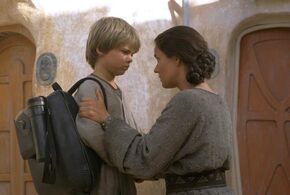
Anakin Skywalker bids farewell to his mother.
The Ugnaughts would pass down vocations – so-called "blood professions" – from generation to generation within each family, teaching the children the necessary skills to mine or be a mechanic.[9]
Relationships between parents
- "You're not married – and you had a baby! You guys are gonna be in so much trouble!"
- ―A gleeful Ben Skywalker to Jacen Solo and Tenel Ka
The act of conceiving a child was typically connected with love and emotional attachments between the parents; this was a common notion among many of the species who reproduced sexually.[47] Among the Gotals, love at first sight was the rule rather than the exception, because Gotals could read each other so well with their unique head cones. Relationships built on love would usually last. They mated for life and would bear children as soon as their lifestyle permitted.[21] Gotals took great delight in the raising of progeny, and their cone sensitivity enabled them to function well as a spouse and parent.[9] Kel Dor couples would begin having children soon after marriage.[9] Some Humans viewed sex as forbidden unless sanctioned by marriage;[48] Boba Fett, for example, believed that sex between those not married was immoral.[49] Having a child out of wedlock was considered scandalous by some Humans.[50] The Arcona regarded a commitment to marry as a commitment to parent,[9] whereas the Nautolans would mate for life and saw a happy mating, or marriage, as a necessary requirement for existence[9].
This was in stark contrast to species like the Goroth,[15] who had no concept of marriage at all. There were many species, like the Ishi Tib of Tibrin,[21] who would never marry and took no wife or husband.
Amongst some species, the concept of romantic love did not factor into reproduction and the raising of children. For the Bith, reproduction was entirely a matter of rational selection. [21] Prospective parents take a sample of their DNA to a Computer Mating Service (CMS), which matches it up with other samples from members of the opposite sex.[21][9] From these comparisons, CMS develops a series of computer models projecting the outcome of a union between the customer and a dozen suitable mates.[21] A prospective parent ranks each combination according to their preferences, and a meeting is arranged between clients who have selected the same combinations in approximately the same order. The prospective parents or their agents will negotiate the number of offspring and how many each parent will receive. Upon arriving at an agreement, the parents send the necessary cells to a so-called Reproduction Center,[21][9]
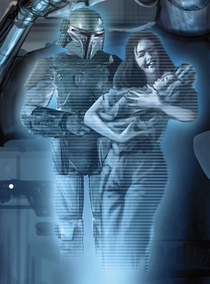
Boba Fett posing with his wife and child. Many families liked to record family holoimages of themselves.
where the genetic material is combined, fertilized, and incubated.[21] After a year, the children are delivered to the parents' door. As they had reproduced in this manner for so long, Bith had lost the ability to conceive naturally,[21][9] because the organs necessary to reproduce organically had atrophied past the point of being able to function in procreation[21]. Amongst the Issori, breedings were negotiated between families, and the female Issori laid eggs which were fertilized by an agent packet produced by a male. The children were raised by the families they were born into. Sometimes, eggs or packets from dead heroes or leaders were used in order to preserve the bloodline; the families always cared for these newborns.[41]
Among the Ho'Din, who worshiped Nature, reproduction was blessed only if the church carried it out. Ho'Din would mate for life. A priestess "gathers" the "seed" of life from the male, distributing it to the female in imitation of the manner insects play a part in the reproduction of plants. Children born without the sanction of the church were drugged into sleep and killed, sacrificed to the forest floor where Nature could purify their soul. (Ho'Din parents rarely made such sacrifices, however, since the species were masters of herbal birth control).[21]
Many species and cultures, like the Besalisk and the Caamasi,[9] placed great importance on monogamous relationships, although there were others species which did quite the opposite. For example:
- Among the Cereans, females made up the majority of the population, with an average ratio of twenty-to-one. Therefore, polygamy was inevitable, with each male taking one "bond-wife" and several other "honor-wives".[9]
- The ideas of marriage and monogamous relationships were unheard of in the Goroth culture. Goroth interbred within their clans, and to breed with a member of another clan brought great shame on the individuals and both clans.[15]
- The Gorvan Horansi, a sub-species of the Horansi species, were polygamous, and a tribe was composed of one male, all of his wives and all of their children.[15]
- The Kaleesh were a polygamous people where each male had multiple wives and many children.[9]
- The insectoid Noehons had a culture in which an alpha male controlled a "harem" of 10 to 50 females.[14]
- A Ranat female would come into "season" at least twice a year. During that time, she would mate with as many male Ranats as possible.[21]
- A Sullustan core-family, or "Warren-clan", was headed by one female, who would have children with several husbands.[9]
Some species had two progenitors, but the resulting offspring was raised by one parent only. Among the Mashi Horansi, the males would raise their young (the Treka Horansi, on the other hand, shared a rough equality in regards to responsibility for their young).[15] When Arcona reproduced, the males usually raised the children, as females were considered more reckless and irresponsible.[9] Devaronian had vastly different personalities, and while the females would live their lives in comfortable homes and raise their young in villages, the males were driven by irresponsible wanderlust and preferred to live their life as vagrants. This kept males and females nearly constantly separated.[21] After choosing a mate and siring children, male Devaronians typically took to the rivers and roads of their homeworld, and many left the planet entirely, rarely ever returning. However, the males would always send some of the money they earned back home to their wives and children. The females actually preferred financial support over having the males present.[9]
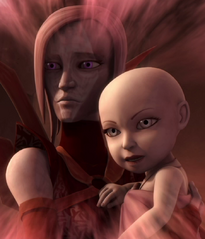
A Dathomirian mother with her infant daughter, Asajj Ventress.
Among some species and culture, the male was killed by the female after mating. Among the insectoid Flakax species, one singular female ruled each community and produced all of its young. The sole job of the males was to aid in reproduction, and after they had served their purpose, they were eaten by the female.[21] In the traditional H'nemthe mating ritual, the female disembowels the male with her razor-sharp tongue. The male considered the ritual a culmination of spiritual fulfillment, as he moves on to the netherworld to guide his coming child.[9] The Nightsisters of Dathomir were a culture of dark side witches. After mating, the child's father was killed by tradition.[51][52]
Many species, like Chagrians,[9] Humans[9] and Trandoshans[9] would normally raise their children in private home groupings, usually the child's parents or family (or both, like the Kel Dor and the Shistavanens[9]). Another example was the Xi'Dec, a unique species of more than 180 sexes, where family units lived apart from other family units while caring for their children within the confines of the family.[21] Kubaz couples shared their apartment with their infants, but children went to live in a family crèche when they were still very young; the equivalent of five standard years. At the crèche, they were cared for by single adult pressures.[21]
Among some species, raising and caring for the young was a task performed by whole group of individuals. The amphibious Multopos lived in tribes, whose primary function was to raise more Multopos. They spent a great deal of time caring for the eggs and the young together, and several adult Multopos would watch the water canals that served as "nurseries".[15] Among the Brubb, the parents went their separate ways after their egg hatched, and the hatchling became a ward of the haba, a group of 10-10,000 couples. Every youngling is considered property of the haba, and every adult takes responsibility for rearing each child.[21] A Ranat female moved her children into a nursery after giving birth to them. There, she and the other mothers would take turns providing minimal care to all the children of the tribe. If the mother died, her children would not miss her-they did not know her from the other nursemaids.[21] Among the Ishi Tib, the responsibility for raising the young fell to the community as a whole, and no one ever knew which child came from which parents.[21]
The Rybet were galactic nomads who only interacted with others of their kind to mate. Xenobiologists estimated that fewer than a billion Rybet existed in the galaxy, possibly due to the pathological hatred male Rybet had for female Rybet and vice versa. Only an overwhelming compulsion to reproduce could overcome the males' fear and loathing of Rybet females. Rybet felt a drive to reproduce only once every ten years after reaching adulthood. The only time where a male and female Rybet lived together for any length of time were in the first years of raising their young. For the first year or two, the parents would stay together, slaving their starships together and taking their parts in raising the young. This arrangement didn't last long, however-eventually, they would start to grate on each other's nerves, and after the first one or two years, the male either left or else would find himself dead or severely maimed. The mother would typically sell the dead male's ship and give the young the resulting credits as start-up money.[8]
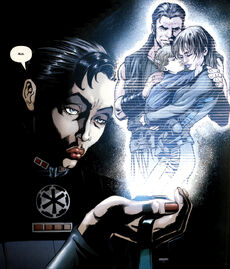
Nyna Calixte, a.k.a. Morrigan Corde, stares at her family holo.
For Brubb females, the process of bringing new life into the world was very stressful. Because of this, they usually died at a younger age than males (in order to prolong their lives, an increasing number of females refused to lay eggs). Because of the toll that process took on their bodies, a Brubb female would lay only a single egg each Barosian year (567 days). The female would select her mate with great care before the mating process. After mating, the male and female would usually protect the nest together. Sometimes, a male would mate with more than one female, which did result in some females being forced to protect the egg all by themselves. Having to guard an egg alone bore such a stigma of disgrace that it was often considered a legitimate excuse for the female to murder the philandering male.[21]
Some species and cultures would mate only once, for life; to the Cathar, the custom was so important that when one mate died, the survivor never had a relationship with another.[53] The Mashi Horansi,[15] a Horansi sup-species,[15] were another notable example.
Other customs
- "You could have had children via a donor. Clinics can do clever things."
"Mando'ade adopt. I chose the finest family a man could have. Why would we have wanted to conceive a child by donor?" - ―Jaina Solo and Gotab
To some species, creating offspring was a duty. The concept of furthering one's family was extremely important to the Sludir of Sluudren. To die without an heir was considered disgraceful, and to deprive a family of an heir was grounds for banishment or execution.[14] A female Yarkora could only bear children every fifteen standard years, and usually only one at the time, making their species very sparse. Every female had to become a mother at some point in her life in order to save the species from extinction.[9]
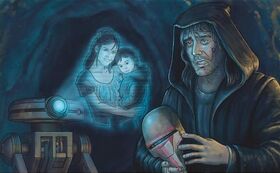
Revan watches a holorecording of his wife and son.
Some species had rather unusual customs when it came to parenting: When the Huhks produced offspring, they left their young – the Lahsbees – with the other Lahsbees. The Huhks and the Lashsbees could not understand each other's languages, and the Huhks did not appear to feel any particular need to protect the Lahsbees. In fact, they found them annoying in the extreme.[54]
Sometimes, the number of children an individual was allowed to have, or whether they were allowed to have offspring at all, was regulated by local laws. The planet Algara II was home to the native Xan and immigrated Humans. The Humans settlers were in complete control of the planet, and the Xan were second-class citizens. As a result, the Human Algarians strictly regulated the number of children the Xan were allowed to have.[15] The Kaminoans controlled their genetic codes through cloning and selective breeding. As such, they were one of the most genetically homogenous species in the galaxy, while the children were made within a set of strict, predetermined genetic parameters.[9] Green eyes, for example, were not allowed, only gray, yellow and blue. There was no room for any other color, and children born with another eye color were killed.[55]
Many societies in the galaxy had techniques for conceiving artificially rather than organically.[56] There were clinics where people could conceive a child via a donor,[57] and a few species were unable to reproduce without technology: Bith had completely lost the ability to conceive naturally,[21][9] and Columi had lost all predisposition towards physical contact, and reproduction had become a technological process.[21].
Biological significance
Most species did reached sexual maturity at a certain age; the Ho'Din, for instance, did this at the age of 30.[21] The Jenets, on the other hand reached full maturity within only one standard year.[21] This quick rise to self-sufficiency meant that Jenet females were free to bear children relatively often, and the time between litters would seldom exceed a standard year.[21]
Amongst some species, their biology meant that raising and caring for the young was done by a group rather than individual parents. The Qieg was a sentient insect species, where the females lay eggs that were fertilized by many males. There were no family units, but all the offspring were raised communally. The Qieg did not consider it important to claim offspring as one's own, and made no effort to determine whether a given infant was their child.[15] The Ishi Tib of Tibrin had no spouses, and mating was governed by momentary desires on the part of the Ishi Tib.[9] Ishi Tib would only mate to reproduce.[8] Once fertilized, the eggs were laid in special hatcheries on the sandbars. The number of eggs allowed to mature was determined by the population requirements of the community, or "school", and the resources of the area where the school lived. The responsibility for raising the young fell to the community as a whole, and no one ever knew which hatchlings came from with parents.[21] Potential partners were tested to verify that no problems would arise for their offspring.[9] The Rakaans had five life phases which corresponded to unique sexes: Child, neuter, female, male and andro. Each Rakaan would normally experience at least three phases during a lifetime. In female phase, the Rakaans laid eggs, which were fertilized by the males. The female would then keep the eggs inside her body. After the gestation period was over, the eggs were released into a nesting chamber where the andros cared for the fertilized eggs.[15] The Lyra were cephalopods with a rigid caste system intricately linked to the number of tentacles possessed by the individual Lyra. The fertilized eggs would hatch within a mother's body, upon which she released them into the sea to be cared for by the four-limbed caste.[21] The Verpine hatchlings were cared for by the entire community.[21]
Priapulin were amphibious gastropods that had a rather bizarre symbiotic[5] relationship with small creatures called food-kin,[5], sentient, crab-like beings[58]. The food-kin provided the Priapulin's nourishment, and were actually proud to fulfill their role as food. Once the Priapulin consumed them, the food-kin's offspring remained inside the Priapulin's body. After a time, the Priapulin gave birth to, and cared for, the food-kin's babies, who in turn would act as food, and so on.[5] The Priapulin would have to eat the food-kin when their biological clock chimed, and before their children spoiled.[58] Priapulin pilot Charza Kwinn even became a smuggler and a pirate in order to feed his food-kin, although he limited his prey to Imperial.[59]
Another species of note were the Fefze. These arthropods resembled beetles, and were one of the rare species with true hive intelligence. One of the highest priorities of a Fefze swarm was to recruit new hatchlings in order to spread its mind base and to prolong its life. This was usually accomplished through a "swarm dance", which were ritualistic gatherings in which swarms met for the purpose of reproducing. Males from each swarm fertilized the eggs of females from other swarms. Most of these eggs were brought back to the swarms' home territory of hatching. The two swarms would then work together to form an egg globule belonging to neither of them. This new globule was abandoned in the hope that it would mature into a new swarm. In this manner, the race was perpetuated through the formation of new swarms. The hatchlings from the egg globule, usually coming from a variety of mothers, matured together, playing and feeding as a group, eventually learning how to operate within one mind.[21]
Some species did not consciously decide to reproduce. For example, the Pulras, who reproduced through fission, would simply start retaining food energy to nourish a new Pulra growing within their bodies. Natural biochemical fluctuations and subtle levels in the environment would dictate population levels.[15] Among the M'shinni, who reproduced through parthenogenesis, reproduction was triggered by climatic conditions; in areas of plentiful food, they would give birth to a single infant once every three standard years.[14] The Sekct, who were also parthenogenetic, would lay a single egg every standard two years, although only one in two eggs would hatch, because the species were so susceptible to random mutations.[15] The Neti procreated by creating a few seeds seeds, which occurred only once every few centuries. Seeds would often sit for over a thousand years before germinating.[8] Sometimes, the new saplings would burst out of the ground after their progenitors death.[60][61]
Some species also had a natural rhythm that ensured the continuation of the species. Rybet males despised and feared their female counterparts, and the only thing that allowed them to overcome this was the species' overwhelming urge to mate and reproduce, which happened only once every ten years after reaching adulthood.[8] Among the Rakaans, the biological change from one sex to another, and the distribution of the sexes, was directly regulated by nature. In times of famine, the neuter population would skyrocket, while in times of severe depopulation, children would mature more quickly, and the male, female and andro population increased at a rapid rate.[15] Bilars ate and slept in groups in order to survive. Bilars born within a few days of each other developed special affinities and became lifelong members of defensive communities. Within a few generations, the Bilar reproductive circle evolved to maximize each youngling's chance to bond with as many children as possible. Most Bilars were conceived and born within only a few hours of one or more other Bilars, and small group of expectant mothers would stay close so that the children would be born in physical proximity.[21]
